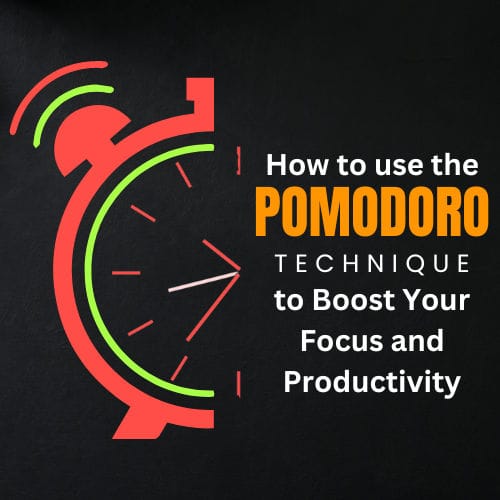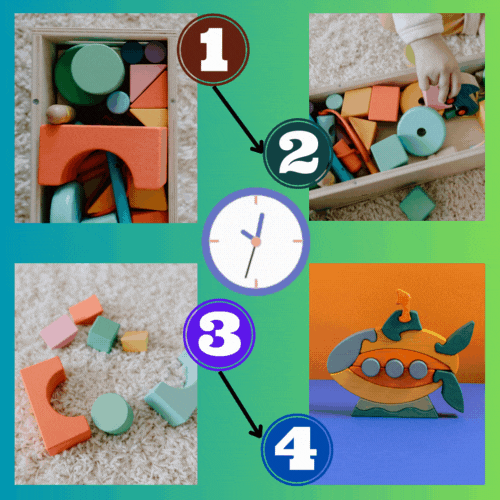Do you ever feel overwhelmed by the amount of work you have to do? Do you struggle to stay focused and motivated on your tasks? Do you often procrastinate or get distracted by other things? If you answered yes to any of these questions, then you might benefit from using the Pomodoro technique.
The Pomodoro technique is a simple but powerful way to boost your productivity and focus by breaking down your work into short intervals of 25 minutes followed by short breaks of 5 minutes.
It was developed by Francesco Cirillo in the late 1980s, when he was a university student struggling to concentrate on his studies. He used a tomato-shaped kitchen timer to set intervals of 25 minutes of focused work, followed by 5 minutes of break. He found that this method helped him overcome procrastination, reduce distractions, and improve his mental stamina.
The term “pomodoro” in Italian directly translates to “tomato,” owing its name to the creator’s utilization of a timer shaped like a tomato.
The Pomodoro technique can help you achieve more in less time by eliminating distractions, improving concentration, enhancing memory retention, and increasing motivation. It can also help you improve your well-being and happiness by reducing stress, anxiety, and fatigue, and increasing your satisfaction and enjoyment of your work.

Table of Contents
In this blog post, you will learn how to use the Pomodoro technique effectively for different types of work or tasks. You will also learn how to customize and adapt the Pomodoro technique to suit your personal style, preferences, and goals. You will also discover some tools and resources that can help you implement the Pomodoro technique easily and efficiently.
How to Use the Pomodoro Technique
Using the Pomodoro technique is very simple and straightforward. All you need is a timer, a task, and a sheet of paper. Here are the steps to follow:
- Set up a timer. You can use any kind of timer that works for you, such as a physical timer, an online timer, an app, or an extension. Some examples of timers that are designed for the Pomodoro technique are [Tomato Timer], [Pomofocus], [Pomodone], [Marinara Timer], etc. You can also customize your timer settings according to your preferences, such as changing the sound, color, or duration of your pomodoros and breaks.
- Choose a task. Pick a task that you want to work on or complete. It can be anything that requires concentration and attention, such as writing, reading, researching, studying, or learning. Make sure that your task is clear and specific enough so that you know what you need to do and how to measure your progress. For example, instead of saying “write a blog post”, say “write an introduction for a blog post on how to use the Pomodoro technique”.
- Start a pomodoro. Start your timer and work on your task for 25 minutes without any interruptions or distractions. This means that you should avoid checking your phone, email, social media, or any other sources of distraction during this time. If something urgent or important comes up during your pomodoro, write it down on a piece of paper and deal with it later. If you finish your task before the timer rings, you can either start working on another task or review your work until the time is up.
- Take a break. When your timer rings, stop working on your task and mark a check on your sheet of paper. This indicates that you have completed one pomodoro. Then take a short break of 5 minutes to relax and refresh yourself. You can do anything that helps you unwind and recharge during this time, such as stretching, breathing, drinking water, listening to music, or meditating.
- Repeat steps 3-4 four times. After four pomodoros (which equals to 100 minutes of work), take a longer break of about 15 to 30 minutes. This will help you prevent mental fatigue and boredom, and enhance your creativity and problem-solving skills. You can use this time to do something more enjoyable or rewarding, such as eating a snack, taking a walk, playing a game, or watching a video.
- Track your progress. At the end of each pomodoro session, review your work and your sheet of paper. See how much you have accomplished and how many pomodoros you have completed. You can also use a tool or an app to track your progress and visualize your data, such as [Toggl Track], [RescueTime], [Clockify], [Focus Booster], etc. Tracking your progress will help you evaluate your performance, identify your strengths and weaknesses, and improve your productivity and focus over time.
How to Use the Pomodoro Technique Effectively
The Pomodoro technique is a simple but effective way to boost your productivity and focus, but it also requires some practice and experimentation to make it work for you.

Here are some best practices and tips that can help you use the Pomodoro technique effectively:
- Break down complex projects into smaller tasks. If you have a large or complex project that you need to work on, such as writing a book, designing a website, or launching a business, you might feel overwhelmed or intimidated by the amount of work involved. To make it easier and more manageable, you can break down your project into smaller tasks that can be completed within one or more pomodoros. For example, instead of saying “write a book”, say “write an outline for chapter 1”, “write the first draft of chapter 1”, “edit and revise chapter 1”, etc.
- Combine small tasks into one pomodoro. If you have several small or simple tasks that you need to do, such as replying to emails, making phone calls, or updating your calendar, you might feel tempted to do them in between your pomodoros or during your breaks. However, this can disrupt your focus and flow, and make you lose track of time. To avoid this, you can combine your small tasks into one pomodoro and do them all at once. For example, instead of saying “reply to email from John”, “call Lisa”, “update calendar”, say “do administrative tasks”.
- Deal with interruptions gracefully. Interruptions are inevitable when you are working on something important or urgent. They can come from external sources, such as phone calls, messages, notifications, or people, or from internal sources, such as thoughts, emotions, or impulses. To deal with interruptions gracefully, you can use the following strategies:
- If the interruption is external and urgent or important, write it down on a piece of paper and deal with it after your pomodoro or during your break. For example, if you receive a phone call from your boss or a client, you can write down their name and number and call them back later.
- If the interruption is external and not urgent or important, ignore it or postpone it until later. For example, if you receive a message from your friend or a notification from social media, you can mute your phone or turn off your notifications and check them later.
- If the interruption is internal and relevant to your task, write it down on a piece of paper and incorporate it into your work later. For example, if you have an idea or a question that is related to your task, you can write it down and explore it further later.
- If the interruption is internal and not relevant to your task, acknowledge it and let it go. For example, if you have a thought or an emotion that is not related to your task, you can notice it and return to your work.
- Adjust the length of your pomodoros and breaks according to your needs and preferences. The standard length of a pomodoro is 25 minutes followed by 5 minutes of break, but this might not suit everyone’s needs and preferences. Some people might find it too short or too long for their type of work or task. Some people might need more or less breaks depending on their energy level or mood. To adjust the length of your pomodoros and breaks according to your needs and preferences, you can use the following guidelines:
- Experiment with different lengths of pomodoros and breaks until you find the optimal one for you. You can try 20, 30, 45, or 60 minutes of work followed by 3, 7, 10, or 15 minutes of break. You can also use a tool or an app that allows you to customize your timer settings, such as Focus To-Do, Be Focused, Pomodoro Tracker, etc.
- Consider the nature and complexity of your work or task. If your work or task is more creative or challenging, you might need longer pomodoros and breaks to maintain your focus and flow. If your work or task is more routine or simple, you might need shorter pomodoros and breaks to avoid boredom and frustration.
- Consider your personal factors and preferences. If you are more alert and energetic in the morning, you might need shorter pomodoros and breaks to keep up with your pace. If you are more tired and sluggish in the afternoon, you might need longer pomodoros and breaks to recharge yourself. You can also adjust your pomodoros and breaks according to your mood, motivation, or interest in your work or task.
How to Integrate the Pomodoro Technique with Other Productivity Methods and Tools
The Pomodoro technique is a powerful productivity method on its own, but it can also be integrated with other productivity methods and tools to enhance its effectiveness and efficiency.
Here are some examples of how you can integrate the Pomodoro technique with other productivity methods and tools:
- SMART goals. SMART goals are goals that are Specific, Measurable, Achievable, Relevant, and Time-bound. They help you define what you want to achieve, how you will measure your progress, whether your goal is realistic and attainable, why your goal is important and meaningful to you, and when you will complete your goal. You can use SMART goals to plan and prioritize your tasks before starting your pomodoros’. For example, instead of saying “I want to write a blog post”, say “I want to write a 3000-word blog post on how to use the Pomodoro technique by Friday”.
- Eisenhower matrix. The Eisenhower matrix is a tool that helps you prioritize your tasks based on their urgency and importance. It divides your tasks into four categories: Do (urgent and important), Schedule (important but not urgent), Delegate (urgent but not important), and Eliminate (neither urgent nor important). You can use the Eisenhower matrix to decide which tasks to work on during your pomodoros. For example, you can work on the Do tasks first, then Schedule tasks, then Delegate tasks, and finally Eliminate tasks.
- Kanban board. A Kanban board is a tool that helps you visualize your workflow and track your progress. It consists of three columns: To Do (tasks that you need to do), Doing (tasks that you are currently working on), and Done (tasks that you have completed). You can use a Kanban board to organize your tasks according to their status and move them across the columns as you complete them during your pomodoros. For example, you can start with all your tasks in the To Do column, then move one task to the Doing column when you start a pomodoro, then move it to the Done column when you finish a pomodoro.
- Todolist app. Todoist is an app that helps you manage your tasks, projects, and goals. It allows you to create, organize, and prioritize your tasks in a simple and intuitive way. You can also set deadlines, reminders, and labels for your tasks to keep track of them. You can use Todoist to plan and schedule your tasks before starting your pomodoros. For example, you can create a project for your blog post, add subtasks for each section or paragraph, set a deadline for each subtask, and assign a priority level for each subtask.
- Pomodoro Tracker. Pomodoro Tracker is an online timer that is designed for the Pomodoro technique. It allows you to set up your timer settings, choose your tasks, start your pomodoros, take your breaks, and track your progress. You can also customize your timer settings, such as changing the sound, color, or duration of your pomodoros and breaks. You can use Pomodoro Tracker to implement the Pomodoro technique easily and efficiently. For example, you can start your timer, work on your task, take a break, and repeat until you finish your task.
How to Achieve a State of Flow with the Pomodoro Technique or its Variation (Flowtime)
One of the ultimate goals of using the Pomodoro technique is to achieve a state of flow. Flow is the optimal state of mind for creativity and productivity, where you are fully immersed and engaged in your work. You lose track of time and self-consciousness, and experience a sense of joy and satisfaction.
Flow was first coined by psychologist Mihaly Csikszentmihalyi in his book [Flow: The Psychology of Optimal Experience]. He identified several characteristics of flow, such as:
- Having a clear goal and immediate feedback
- Having a balance between challenge and skill
- Having a sense of control and autonomy
- Having a high level of concentration and focus
- Having a loss of self-awareness and ego
- Having a distortion of time perception
- Having an intrinsic motivation and enjoyment
Achieving a state of flow can have many benefits for your work and well-being, such as:
- Improving your performance and output
- Enhancing your creativity and problem-solving skills
- Increasing your learning and memory retention
- Boosting your motivation and confidence
- Reducing your stress and anxiety
- Increasing your happiness and fulfillment

To achieve a state of flow with the Pomodoro technique or its variation (Flowtime), you can follow these steps:
- Choose a task that is meaningful and enjoyable to you. It should be something that you are passionate about or interested in, something that has a purpose or value to you, something that you find fun or rewarding. For example, if you love writing, you can choose to write a blog post on a topic that you are curious about or excited about.
- Set a challenge that matches your skill level. It should be something that is neither too easy nor too hard for you, something that pushes you out of your comfort zone but not beyond your capabilities, something that requires your full attention but not overwhelming you. For example, if you are writing a blog post, you can set a challenge such as writing 3000 words in 2 hours, or writing in a different style or tone than usual, or writing about something that you have never written before.
- Eliminate distractions and interruptions. It should be something that minimizes or removes any external or internal sources of distraction or interruption, something that creates a conducive environment for your work, something that helps you focus on your task and nothing else. For example, if you are writing a blog post, you can eliminate distractions such as turning off your phone, email, social media, or any other notifications, closing any irrelevant tabs or windows on your browser, wearing headphones or earplugs to block out any noise, working in a quiet or isolated place, or telling others not to disturb you.
- Monitor your feedback and adjust accordingly. It should be something that provides you with clear and immediate feedback on your progress and performance, something that helps you measure your results and outcomes, something that helps you improve your work quality and efficiency. For example, if you are writing a blog post, you can monitor your feedback such as checking your word count, reading your draft, editing and revising your work, asking for feedback from others, or publishing your work.
You can use the Pomodoro technique or its variation (Flowtime) to achieve a state of flow by following these steps:
- If you are using the Pomodoro technique, you can set up your timer for 25 minutes of work followed by 5 minutes of break, and repeat until you finish your task. You can also adjust the length of your pomodoros and breaks according to your needs and preferences. You can use any kind of timer that works for you, such as [Tomato Timer], [Pomofocus], [Pomodone], [Marinara Timer], etc.
- If you are using the Flowtime technique, you can adjust the length of your work and break intervals based on your natural rhythm and flow. You can start working on your task until you feel like taking a break, and then take a break until you feel like working again. You can also use any kind of timer that works for you, such as [Focus To-Do], [Be Focused], [Pomodoro Tracker], etc.
How to Improve Your Well-Being and Happiness with the Pomodoro Technique
The Pomodoro technique is not only a productivity method, but also a well-being and happiness booster. It can help you reduce stress, anxiety, and fatigue, and increase your satisfaction and enjoyment of your work.
Here are some of the ways that the Pomodoro technique can improve your well-being and happiness:
- It helps you manage your time and energy better. By breaking down your work into short intervals of 25 minutes followed by short breaks of 5 minutes, you can avoid wasting time and energy on unimportant or irrelevant things. You can also avoid overworking or underworking yourself by finding the optimal balance between challenge and skill. You can also plan and schedule your tasks according to your priorities and deadlines. This way, you can feel more in control and confident about your work.
- It helps you avoid procrastination and distraction. By setting a timer and working on a single task for 25 minutes without any interruptions or distractions, you can overcome procrastination and distraction. You can also avoid the negative consequences of procrastination and distraction, such as guilt, regret, frustration, or anxiety. You can also enjoy the positive outcomes of completing your tasks on time and with quality, such as satisfaction, pride, or recognition.
- It helps you boost your concentration and creativity. By taking short breaks of 5 minutes after each pomodoro, you can refresh and recharge yourself. You can also use this time to do something relaxing or enjoyable, such as stretching, breathing, drinking water, listening to music, or meditating. This way, you can prevent mental fatigue and boredom, and enhance your concentration and creativity. You can also achieve a state of flow, which is the optimal state of mind for creativity and productivity.
- It helps you improve your learning and memory. By working on a task for 25 minutes followed by a break of 5 minutes, you can improve your learning and memory. This is because this pattern mimics the natural cycle of your brain’s activity and rest. By working on a task for 25 minutes, you activate your brain’s focused mode, which is responsible for processing new information and solving problems. By taking a break of 5 minutes, you activate your brain’s diffuse mode, which is responsible for consolidating information and making connections. This way, you can enhance your memory retention and comprehension.
To improve your well-being and happiness with the Pomodoro technique, you can
Follow these tips and suggestions:
- Take care of your physical and mental health. The Pomodoro technique can help you improve your physical and mental health by reducing stress, anxiety, and fatigue, and increasing your satisfaction and enjoyment of your work. However, you also need to take care of your physical and mental health by doing other things, such as eating healthy, sleeping well, exercising regularly, meditating daily, or seeking professional help if needed.
- Reward yourself for completing your tasks or goals. The Pomodoro technique can help you motivate yourself by providing you with clear and immediate feedback on your progress and performance. However, you also need to reward yourself for completing your tasks or goals by doing something that makes you happy or proud, such as eating a treat, buying something nice, watching a movie, or sharing your achievements with others.
- Celebrate your achievements with others. The Pomodoro technique can help you achieve more in less time by eliminating distractions, improving concentration, enhancing memory retention, and increasing motivation. However, you also need to celebrate your achievements with others by sharing your work or results with them, asking for feedback or praise from them, or collaborating or learning from them. This way, you can feel more connected and supported by others, and also learn from their experiences and insights.
- Have fun with the Pomodoro technique. The Pomodoro technique can help you enjoy your work more by making it more fun and rewarding. However, you also need to have fun with the Pomodoro technique by experimenting with different lengths of pomodoros and breaks, different types of tasks and activities, and different ways of tracking and rewarding your progress. You can also have fun with the Pomodoro technique by using different timers, apps, extensions, books, or articles that are designed for the Pomodoro technique, such as Tomato Timer, Pomofocus, Pomodone, Marinara Timer, Toggl Track, RescueTime, Clockify, Focus Booster, The Pomodoro Technique by Francesco Cirillo, Pomodoro Technique Illustrated by Staffan Noteberg, etc.
Download Resource
You can download a simple and fully featured Pomodoro timer called Marinara from Github or add its extension from the Chrome store (don’t worry about the notification).
Conclusion
In this blog post, we have showed you how to use the Pomodoro technique to boost your focus and productivity. You have also read how to use the Pomodoro technique effectively, how to integrate it with other productivity methods and tools, how to achieve a state of flow with it or its variation (Flowtime), and how to improve your well-being and happiness with it.
Here are the main points that we have discussed in this post:
- The Pomodoro technique is a simple but powerful way to boost your productivity and focus by breaking down your work into short intervals of 25 minutes followed by short breaks of 5 minutes.
- The Pomodoro technique can help you achieve more in less time by eliminating distractions, improving concentration, enhancing memory retention, and increasing motivation. It can also help you improve your well-being and happiness by reducing stress, anxiety, and fatigue, and increasing your satisfaction and enjoyment of your work.
- To use the Pomodoro technique effectively, you need to set up a timer, choose a task, start a pomodoro, take a break, and track your progress. You also need to break down complex projects into smaller tasks, combine small tasks into one pomodoro, deal with interruptions gracefully, and adjust the length of your pomodoros and breaks according to your needs and preferences.
- To integrate the Pomodoro technique with other productivity methods and tools, you can use SMART goals, Eisenhower matrix, Kanban board, Todoist app, Pomodoro Tracker, etc. These methods and tools can help you plan and prioritize your tasks, visualize your workflow and track your progress, measure your results and outcomes, and improve your work quality and efficiency.
- To achieve a state of flow with the Pomodoro technique or its variation (Flowtime), you need to choose a task that is meaningful and enjoyable to you, set a challenge that matches your skill level, eliminate distractions and interruptions, and monitor your feedback and adjust accordingly. Achieving a state of flow can enhance your creativity and productivity by making you fully immersed and engaged in your work.
To improve your well-being and happiness with the Pomodoro technique, you need to take care of your physical and mental health, reward yourself for completing your tasks or goals, celebrate your achievements with others, and have fun with the Pomodoro technique.
These tips and suggestions can help you reduce stress, anxiety, and fatigue, and increase your satisfaction and enjoyment of your work.
The Pomodoro technique is a simple but effective way to boost your focus and productivity. It can also help you improve your well-being and happiness. Why not give it a try for yourself? You might be surprised by how much you can achieve in less time with more fun.
Start using the Pomodoro technique today and see the difference for yourself! Share your feedback and suggestions in the comments section below.





This is the perfect website I was looking for, and I’m thrilled that I found it on Bing; I’ve bookmarked it.
Just wish to say your article is as surprising The clearness in your post is just cool and i could assume youre an expert on this subject Fine with your permission allow me to grab your RSS feed to keep updated with forthcoming post Thanks a million and please keep up the enjoyable work